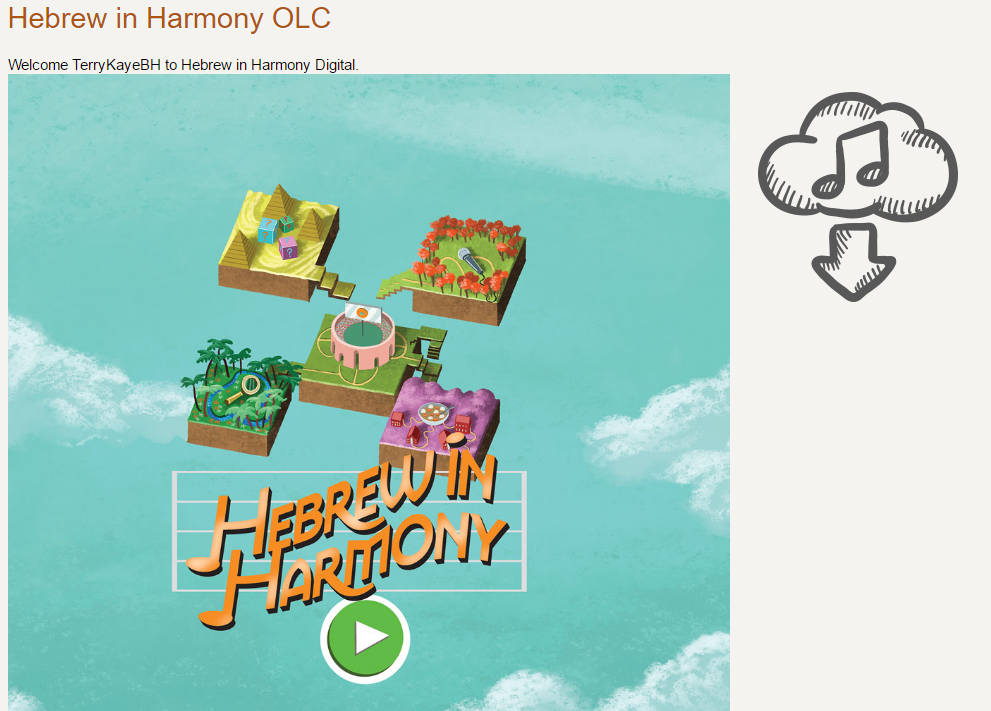- Home
- Play & Learn Home
- Online Enrichment
- Experience Modern Israel
- Israel It's Complicated
- Jewish and Me
- Jewish Holidays Jewish Values
- Jewish Values in Genesis and Jewish Values in Exodus
- Min Ha’aretz
- Our Place in the Universe
- Simply Seder
- The Prophets: Speaking Out for Justice
- Making T'filah Meaningful
- Make, Create, Celebrate
- Yom Haatzmaut Resources
- Hebrew Apps
- About The OLC
- What is the OLC?
- Introduction
- Get Started
- Resources
- OLC Content
- Parent Materials
- See My OLC Classes
- Store
5 Things to Know Before You Begin Hebrew in Harmony
Here are some tips to help you and your students succeed with Hebrew in Harmony:
1. Use the Curriculum Core. You’ll find three fully scripted lesson plans (how to use the music, when to use the journal, etc.) for each prayer. Review the full module, then choose the activities you want. It’s like baking a cake: Review the ingredients and directions before turning on the oven!
2. Use the music. That’s what makes this program unique: the music!
 Download or stream the songs: www.behrmanhouse.com/HiH (bottom right, “All the music”)
Download or stream the songs: www.behrmanhouse.com/HiH (bottom right, “All the music”)
You can also get the music through the web app. Look for the cloud on the right and click to download or stream the songs. The web app requires a digital license.
Attach speakers to your computer or mobile device and play the songs in class.
3. Give students the digital app to use in class or in their own time. You can play the music in class, watch the videos together, and have students play with the digital alone or in pairs. It’s also ideal for at-home practice. And a great way to involve families. “All Access Digital” (all 22 prayers) is $9.95 per user for a 12-month license. Students can even record themselves reading or singing the prayers and upload to you. You can assess your students by listening and giving them feedback in the app.
4. Use the journals purposefully. Every journal activity is tied to a Curriculum Core (CC) activity. For example, there are three CC lessons and three journal lessons per module. Each CC lesson begins with a “Start” activity directing you to that activity in the journal. Assign journal activities with intentionality. Let students work in chavruta or small groups. Review and discuss their responses together. You will build community at the same time!
5. Differentiate your teaching, allowing for student choice. Students have their preferred ways of learning. Some children like writing their reflections in the journal while others prefer drawing; some like the movement, others want to talk, talk, talk. If kids are uncomfortable expressing their feelings, let them just listen at first and join in later. Meet them where they are comfortable; for example, with questions about their own lives or sports figures or popular culture. Push them just a little bit; for example, by trying out simple mindfulness activities. Affirm them for trying!
In summary, ALL components of Hebrew in Harmony—Curriculum Core, student journals, and digital (especially the music)—are integral and essential parts of the program. By using them all you will give your students the richest, most exciting Hebrew journey they’ve ever taken.

